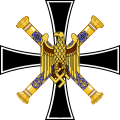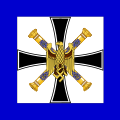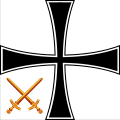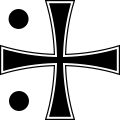Navy
|
Navy |
|
|---|---|
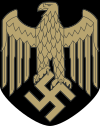
|
|
| active | June 1, 1935 to July 21, 1945 ( OKM dissolved ) and December 31, 1947 ( German mine clearance service dissolved ) |
| Country |
|
| Armed forces | Wehrmacht |
| Type | Armed forces |
| Seat of the OKM | Shell House , Berlin |
| Commander in Chief of the Navy | |
| 1935-1943 | Erich Raeder |
| 1943-1945 | Karl Doenitz |
| insignia | |
| Reich war flag 1935–1938 |
|
| Reich war flag 1938–1945 |
|
| National emblems on uniforms |
|
The Kriegsmarine was the official name of the naval forces of the German Wehrmacht after the Reichsmarine of the German Reich was renamed accordingly on June 1, 1935. The name was already common in parlance and served to distinguish it from the merchant navy . At the same time of the previous Naval Command , the Supreme Command of the Navy .
history
Pre-war period
According to the provisions of the Versailles Treaty , after the First World War Germany was only allowed to maintain a small fleet that was just sufficient for coastal protection. She got the name Reichsmarine . On November 15, 1932, the Reich government adopted a fleet development plan that also provided for airplanes, an aircraft carrier and submarines , i.e. weapon systems that were forbidden to the German armed forces under the Versailles Treaty. After the takeover of the Nazi Party in January 1933 changed on naval armament program first little since Hitler Britain did not want to provoke a naval armaments. With the naval agreement of June 18, 1935, the victorious power of the First World War , contrary to the provisions of the Versailles Treaty, allowed the construction of a German fleet of 35 percent in each ship class of the British surface tonnage and 45 percent of the tonnage for submarines. If the Navy saw itself responsible for the control of the Baltic Sea and for a naval war against France , in 1938 Hitler demanded a fleet strength that could also survive a naval war against Great Britain. This is how plans X, Y and Z came about, of which Hitler approved Plan Z on January 27, 1939 . For this purpose, a large number of new warships of all classes were to be built by 1947, brought forward by Hitler to 1945.
In 1935, the Reichsmarine was renamed the Kriegsmarine and introduced as the new war flag of the Wehrmacht , and thus also at sea, the swastika flag with the iron cross in the left upper corner and a black, white-backed German order cross .
The navy was used for the first time in the Spanish Civil War . Together with naval forces from Great Britain , Italy and France, she participated in the international naval blockade to enforce an arms embargo against Spain , with a coastal area in the Mediterranean between Almería and Valencia being assigned to her. In fact, this mission served to support the coup d'état Spanish nationalists under Franco . On May 29, 1937, the ironclad Germany was bombed and damaged off Ibiza .
Expansion of the officer corps
In the course of the armament of the Wehrmacht , the officer corps of the Navy grew .
| Naval officers | November 1, 1935 | November 1, 1936 | November 1, 1937 | November 1, 1938 |
|---|---|---|---|---|
| Grand Admirals | ./. | ./. | ./. | ./. |
| Admirals General | ./. | 1 | 1 | 1 |
| Admirals | 1 | 3 | 4th | 6th |
| Vice admirals | 5 | 4th | 8th | 10 |
| Rear admirals | 16 | 17th | 17th | 20th |
| Sea captains | 48 | 57 | 71 | 82 |
| Frigate captains | 30th | 42 | 65 | 70 |
| Corvette captains | 142 | 159 | 159 | 150 |
| Captain lieutenant | 237 | 281 | 260 | 258 |
| First lieutenant at sea | 171 | 101 | 203 | 294 |
| Lieutenant at sea | 99 | 254 | 298 | 762 |
| total | 749 | 919 | 1,086 | 1,653 |
| Remaining officers | November 1, 1935 | November 1, 1936 | November 1, 1937 | November 1, 1938 |
| Supplement officers | 334 | 414 | 560 | 625 |
| Engineer officers | 282 | 372 | 522 | 648 |
| Marine Medical Officers | 145 | 188 | 220 | 227 |
| Weapons officers | 118 | 166 | 201 | 264 |
| Administrative officers | 117 | 189 | 215 | 261 |
| total | 996 | 1,329 | 1,718 | 2,025 |
| All in all | 1,745 | 2,248 | 2,804 | 3,678 |
Second World War
It is true that by the beginning of the war in 1939, the number of employees increased from 15,000 to over 78,000. However, too little of the extensive material plans had been implemented at the start of the war to prepare the Navy for the Second World War . Your Commander in Chief, Grand Admiral Erich Raeder noted in the war diary of the Naval War Command on September 3, 1939 :
"The surface forces are still so few in number and strength compared to the English fleet that - provided they are fully committed - they can only show that they know how to die with decency and are thus willing to create the basis for a later reconstruction."
The Navy was nevertheless involved in the war from the start. The liner Schleswig-Holstein opened fire on the Westerplatte on September 1, 1939 at 4:45 a.m. in Danzig . The attack on Poland began as a prelude to the Second World War. Long before the attack date, submarines, the armored ships Admiral Graf Spee and Deutschland and supply ships had left and taken waiting positions at sea.
From the beginning of the war, the Navy began a trade war in the Atlantic (see Atlantic Battle ), the aim of which was to bring British merchant shipping to a standstill. Despite the restrictions imposed by the price order , this soon led to supply bottlenecks in Great Britain. The armored ships of the Deutschland class , submarines and auxiliary cruisers were able to achieve quick successes. However, the Admiral Graf Spee was already lost in December 1939 in the Río de la Plata . In the first year of the war in particular, the prize was still used for fighting, but no later than when the United States entered World War II in December 1941, all restrictions in naval warfare were lifted.
The navy played a key role in the Weser Exercise , the occupation of Denmark and Norway in April 1940. During the occupation of Norway, the Navy lost nine submarines in addition to the heavy cruiser Blücher , the two light cruisers Königsberg and Karlsruhe and the artillery school ship Brummer . Ten destroyers were lost in the battle for Narvik . Due to these high losses, the Navy had to accept this operation as a strategic defeat, despite the successful occupation of Norway.
In July 1940 Hitler gave the order to plan the Operation Sea Lion , the landing in England, which Raeder opposed from the beginning due to the weakness of the Kriegsmarine compared to the Royal Navy . The Commander-in-Chief of the Navy had already called for complete air control over the landing areas during the company's planning phase , as the Navy alone would not have been able to keep the British fleet away from the designated landing zones. The failure of the Luftwaffe in the Battle of Britain probably caused Hitler not to give the order to carry out the planned landing in England.
Due to the clear numerical inferiority, especially among the larger combat ships, which was reinforced by early losses ( Admiral Graf Spee (1939), Blücher (1940), Bismarck (1941)), the navy shifted more and more to war with submarines, largely forced by their commander, Admiral Karl Dönitz . In addition, coastal warfare with small vehicles such as minesweepers and speedboats made up a large part of German naval activities in World War II.

Despite initial successes in the North Atlantic , which brought Great Britain into a supply crisis at times, it was not possible to bring the enemy to their knees with submarines. Only from February to December 1942 operated the Navy under a not decrypted code; the rest of the time the British decoded this code.
As in the First World War , the Allies were in control of the sea . They cut off Germany from maritime trade and from overseas supplies. Grand Admiral Erich Raeder resigned from his post as commander-in-chief at the beginning of January 1943 after the failure of the battle in the Barents Sea and a subsequent fit of rage by Hitler , in which he insulted Raeder and the entire navy. Hitler tried to persuade him to stay, but this time he was unsuccessful. The commander of the submarines Admiral Dönitz was appointed as his successor on January 30, 1943. Raeder himself was appointed admiral inspector of the Kriegsmarine , a post without authority and without authority.
From 1943 to 1945 Dönitz continued to pursue his strategy of submarine warfare ; almost all surface operations were suspended. A large-scale submarine construction program has started. Due to the superior technology of the Allies, especially through ASDIC and later radar , the German submarines could no longer build on their old successes. In 1943 alone, 237 submarines were lost, with the sunk tonnage falling from 8 million GRT in 1942 to 3.5 million tons in the following year. This development continued until the end of the war: in 1944 and 1945 only 1.5 million GRT were sunk. In contrast, there were 241 submarines lost in 1944 and a further 153 submarines from January to May 1945. At the same time, the Allies were even able to increase their cargo capacity through the Liberty freighter construction program. Despite the high losses, the submarine war continued until the end of the war. Doenitz hoped that this would at least tie up material and personnel from the Allies and thus relieve the army. In 1944 the construction of a fleet of modern type XXI and XXIII submarines began , which should have turned the war in the Atlantic. The first of these boats came into service shortly before the end of the war. The implementation of Operation Rainbow was banned by Doenitz though; Nevertheless, many crews sank their submarines themselves.
From the beginning of 1945 until partly after the end of the war in May 1945, ships of the war and merchant navy played a major role in the repatriation of German armed forces and civilian refugees across the Baltic Sea . Despite the high number of people who perished (including the sinking of the Wilhelm Gustloff , the Cap Arcona , the Goya and the Steuben ), over two million people managed to move from the coastal areas threatened by the Red Army to the southern Baltic Sea save - the largest evacuation in human history. About one percent of the people transported died in the transport. Nevertheless, the individual ship losses have gone down in recent German history as traumatic events.
After the end of the war
After the end of the war, parts of the navy continued to be used under Allied control to clear the sea mines on the German coasts. This German mine clearance service existed until the end of 1947 and with up to 300 vehicles with 27,000 men was at times larger than the Reichsmarine before 1935. In addition to Soviet protests, it was above all the cohesion and corps spirit of these former naval units that the Allies decided to dissolve in 1947 initiated, but continued to maintain minesweeping associations and service groups with personnel and material of the Kriegsmarine for various tasks.
The swastika flag was no longer allowed to be used after the surrender . The Allies instructed to use an international signal flag "C", modified as a double stand, which was carried by German ships until 1951. On May 16, 1945, the last Reich government in Flensburg - Mürwik ordered that the German warships deployed in the mine clearance service on behalf of the British have to use the national signal pennant "8" on the gaff .
The naval war courts remained active until June 22, 1945, also in the areas still occupied by German naval forces in the Netherlands, Denmark and Norway. . According to Allied Military Law No 153 of May 4, 1945 German were sentenced to death before the enforcement submit Allied instances for testing; however, the order was disregarded several times due to alleged ignorance. This not only affected judgments shortly before or after the capitulation, but also old cases, e.g. B. of deserters who, after the surrender, were taken into Allied custody as prisoners of war and from there transferred to German courts-martial.
At its third meeting on July 19, 1945 , the Potsdam Conference decided on the distribution of the war and merchant ships that had fallen into the hands of the Allies at the end of the war . An agreement was reached on the distribution of the merchant ships and most of the submarines, with the exception of a few To sink trial specimens. For the remaining warships and auxiliary ships, a commission of flag officers from the victorious powers participating in the conference was formed after a lengthy debate . It formed three groups of equal value, each with a number of serviceable ships and ships in need of repair. Then the groups were allocated to the three victorious powers by drawing lots. Around 500 warships, 30 submarines and 1,329 auxiliary ships were raffled off.
losses
From September 1, 1939 to January 31, 1945, the Navy lost a total of 48,904 soldiers (2,475 of them officers) as dead, 25,259 (554) soldiers as wounded and 100,256 (2,174) soldiers as missing.
Ships and boats were lost: 4 battleships, 5 heavy cruisers, 4 light cruisers, 2 old ships of the line, 27 destroyers, 68 torpedo boats, 27 escort boats, 106 minesweepers, 185 clearing boats, 152 speedboats, 968 submarines, 525 naval ferry boats, 9 auxiliary cruisers , 35 mine ships, 66 barrier breakers, 3 mine clearance ships, 132 auxiliary minesweepers, 137 submarine hunters, 189 outpost boats, 278 coastal and harbor protection boats, 86 security boats, 21 auxiliary escort boats and approx. 200 other ships and boats.
Ship names
The ships of the Kriegsmarine - like the units of the Reichsmarine - did not have any ship name prefixes , as was still common in the Imperial Navy ( SMS ).
organization
The High Command of the Navy was from 1934 in the shell house located on Tirpitzufer (now Reichpietschufer) in Berlin. At the beginning of the war, a bunkered headquarters with the code name Koralle was set up in Lobetal near Berlin for the naval warfare command on an area that originally belonged to the Hope Valley institutions Lobetal .
- Commander in chief
- Erich Raeder , 1928 to January 30, 1943
- Karl Dönitz , January 30, 1943 to April 30, 1945
- Hans-Georg von Friedeburg , 1. – 23. May 1945
- Walter Warzecha , May 23 to July 22, 1945, charged by the Allies with running the business
Ranks and insignia
Officers
| Admirals | Officers | |||||||||||
|---|---|---|---|---|---|---|---|---|---|---|---|---|
|
|
|
|
|
|
|
|
|
|
|
|
|
|

|

|

|

|

|

|

|

|

|

|

|

|
|
|
Grand Admiral |
Admiral General |
admiral |
Vice admiral |
Rear admiral |
Commodore |
Sea captain |
Frigate captain |
Corvette Captain |
Lieutenant captain |
First lieutenant at sea |
Lieutenant at sea |
|
- Officer Candidate (OA)
| Officer Candidates | |
|---|---|

|

|
| Senior ensign at sea | Ensign at sea |
NCOs with portepée (boatmen)
| Boatmen | ||||
|---|---|---|---|---|
|
|
|
|
|
|
| Chief of Staff | Captain | Staff Captain | Boatswain | |
NCOs without portepée (mate)
| designation | Maate (OR-5) | |||
|---|---|---|---|---|
|
Collar tab (rank badge) |

|

|
||
|
Sleeve braid (career badge left upper arm) |

|

|

|

|
| Rank | Chief mate | Mate | ||
| career | Chief mate | Captain's mate | Helmsman's mate | Boatswain's mate |
Teams
| Sailors | |||||||
|---|---|---|---|---|---|---|---|

|

|

|

|

|
|
||
| Corporal corporal | Corporal corporal | Sailor corporal | Seaman Corporal | Private corporal | sailor | ||
Command and rank flags of the Navy
See also
- History of the German Navy
- Naval Officer (Germany)
- Small combat units of the Kriegsmarine
- List of German submarines (1935–1945) / U 1 – U 250
- List of ships of the Kriegsmarine
- Reich war flag
- Troop flag (Wehrmacht)
- Military personnel of the Kriegsmarine
- List of historical naval forces
literature
- Erich Gröner and Dieter Jung: The ships of the German Navy and Air Force 1939–1945 and their whereabouts , Bernard & Graefe Verlag, Bonn 2001, ISBN 3-7637-6215-9 .
- Siegfried Breyer and Ulrich Erfrath: The German Navy 1939-1945 , 4 volumes, Podzun-Pallas Verlag, ISBN 3-89350-699-3 .
- Maik Nolte: “[…] know how to die with decency.” - Fleet armament between Tirpitzian tradition, strategic necessity and ideological calculation 1933–1943 , Der Andere Verlag, Tönning et al. 2005, ISBN 3-89959-386-3 .
Web links
- Jürgen Rohwer , Gerhard Hümmelchen : Chronicle of the naval war 1939–1945 at the Württemberg State Library , library for contemporary history
- Navy at Uboatnet
Individual evidence
- ↑ Reinhard Stumpf: The Wehrmacht Elite: Structure of rank and origin of German generals and admirals 1933-1945 . 2017 ( limited preview in Google Book Search).
- ↑ Defense history training center of the Naval School Mürwik
- ↑ a b c and Military Reconnaissance
- ^ Andreas Herzfeld. Radio message to all - The last flag arrangement of the German Reich . In: Marineforum 5-2010 p. 51.
- ↑ On-board dish: s. Currently shot . In: Der Spiegel . No. 28 , 1965, p. 30-31 ( Online - July 7, 1965 ).
- ↑ Courts of War: Humanly oppressive . In: Der Spiegel . No. 38 , 1966, pp. 58-61 ( online - 12 September 1966 ).
- ↑ Hans Mehl. A fleet out of the hat . In: Marineforum 12-2008, p. 44.
- ↑ Percy E. Schramm : War Diary of the High Command of the Wehrmacht 1944–1945 , Part 2, Bernard & Graefe Verlag, Bonn, ISBN 3-7637-5933-6 , pp. 1509–1511.
- ^ Percy E. Schramm: War Diary of the High Command of the Wehrmacht 1944–1945 , Part 2, Bernard & Graefe Verlag, Bonn, ISBN 3-7637-5933-6 , p. 1513.
- ↑ For the organization of the Kriegsmarine see: Konrad Ehrensberger, 100 years Organization of the German Navy, Bonn 1993, ISBN 3-7637-5913-1 .






